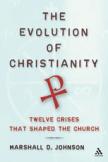No Tradition?
The title of this book is misleading. The book is not about the evolution of Christianity but about the evolution of doctrine—or theology, as Marshall D. Johnson calls it in his introduction. The 12 crises, therefore, are crises about what Christians normatively believe. The author, whose prior books include Making Sense of the Bible, designates the Trinitarian/Christological controversies of the fourth and fifth centuries, for instance, as crisis four, “The Crisis of Monotheism.” Crisis 11 is “Copernicus, Darwin, and Freud: The Crisis of Modernist Worldviews,” and crisis 12 is “The Challenge to Christian Faith Today: The Crisis of Postmodernism.”
With only 200 pages at his disposal, the author does about as well as anybody could in the task he set himself. He is clear and, perforce, concise. Without recourse to jargon, he writes accurately about the tangled issues he deals with. For the most part he covers familiar ground, but in chapters 11 and 12 he moves into areas that do not always figure in “histories of theology.”
These features, plus summaries and charts, make the book read and feel like a textbook, which is probably what Johnson at least partly had in mind. Like most textbooks, this one moves at such a high level of generalization that I fear not much is going to stick with the reader unless it is somehow reinforced elsewhere. The book sometimes reads like a distillation of lectures from a history of theology course.
Marshall, in any case, weaves a seamless chronological narrative from New Testament times up to the present, so he sometimes has to understand theological crises rather broadly. Chapter 7, for instance, is “The Crusades: The Crisis of Islam.” Those eight pages are pretty much straight “church history.” The same could be said for the next chapter, “Scholastics, Friars, Heretics, and Mystics: Crises of Spirituality,” which gets us through the High and Late Middle Ages. This is one of the more disappointing chapters, not much more than a collection of summary statements about people and institutions. Like so many authors, Marshall fails to see how the rise of the universities and the concomitant development of the scholastic method brought about a revolution in “doctrine” and in “theology” that went far beyond any characteristic teachings or approaches of those professors. He conveys nothing of the momentous shift in culture that took place, whose effects are very much with us today.
Chapter 9, on the Reformation, is at 28 pages the longest, which is a not insignificant indication of Johnson’s interests. It deals mostly with doctrinal/theological issues but tries to put them into the framework of their times by providing, for example, a dynastic chart for the House of Habsburg and a list of Henry VIII’s wives. It handles “The Roman Reformation (Counter Reformation)” in a little over three pages—the Jesuits, the Inquisition and the doctrinal decisions of the Council of Trent. (The Grand Inquisitor Torquemada, by the way, sent about 2,000 persons to their death, not 10,000—if that’s any consolation to you.)
From the 16th century forward, Roman Catholicism, it seems, ceased to exist. No movement, issue or person identifiable with it is mentioned for the last 40 pages. Well, that’s not quite true. Copernicus, identified as “a monk,” gets his due, and Pope Clement VII gets a line for complaining that “Copernicus had the temerity to contradict Aristotle.” Liberation theology merits a paragraph (page 177), but except for the footnote at the end of it that cites Gustavo Gutiérrez, there is no indication that this movement is largely of Catholic inspiration.
But where is Newman, where is Loisy, where is “la nouvelle théologie”—where, indeed, is the Second Vatican Council? It is especially stunning that when Johnson describes the ecumenical movement in the 20th century, he does not mention the council. What does this tell us about him, about the state of “the history of theology” or about the council itself? I could not help noting that among the recommendations for “Further Reading” at the back of the book, only one title by a Catholic is mentioned—and that is a bibliographic work, not an original contribution.
So, readers of America, be forewarned. This imbalance does not necessarily mean you will not profit from the book, most especially its last 40 pages, which deal with some subjects most Catholics know little about, such as Lutheran Orthodoxy and Pietism. Those pages provide a fleeting glimpse—very fleeting—into the problem postmodernity poses for the theological enterprise. They will not, however, tell you anything directly about your own tradition. They imply, in fact, that for 400 years that tradition has had nothing important to say, nothing worth reporting to those who live outside it. What do you think? Could Johnson be right about that?
This article also appeared in print, under the headline “No Tradition?,” in the April 25, 2005, issue.







